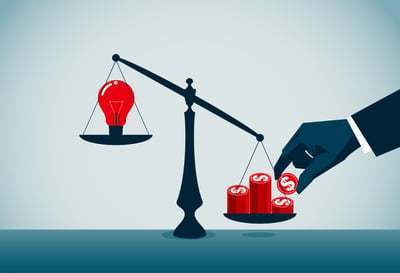September 22, 2025
 by Soundarya Jayaraman / September 22, 2025
by Soundarya Jayaraman / September 22, 2025

If you’ve ever felt stuck choosing between the safety of bonds and the growth potential of stocks, convertible bonds might be exactly what you’re looking for.
Convertible bonds are hybrid securities that act like regular bonds but can convert into a fixed number of shares of the issuing company's stock. Investors earn interest until conversion, offering both fixed income and potential equity upside. Companies use them to lower borrowing costs while delaying stock dilution.
Think of them as a “best of both worlds” investment: you get the steady income of a bond, but with the option to convert into company stock if things take off.
These hybrid securities are often issued by companies to institutional investors who provide portfolio management services to their clients using wealth management tools.
Convertibles are also accessible to retail investors through brokerages (though usually after the initial offering) or via mutual funds and ETFs dedicated to convertible strategies. In this article, I’ll break down what convertible bonds are, how they work, and why they’re worth considering.
Convertible bonds begin as debt: the company raises capital and pays regular interest like a traditional bond. What makes them different is the built-in option for investors to exchange the bond for shares of the issuing company.
In the long term, convertible bonds may fit into a company’s capital structure as either debt financing or shareholder equity, depending on the bondholder’s action.
If converted, the company reduces its debt and issues equity instead. If not, the investor continues receiving interest until maturity, when the principal is repaid. This flexibility is what makes convertibles appealing.
This ability to switch from debt to equity doesn’t happen randomly. It’s governed by specific terms set when the bond is issued. The most important of these is the conversion ratio and conversion price.
The conversion ratio tells investors how many shares of stock they receive when they convert a bond. It is calculated by dividing the bond’s par value by the conversion price.
Conversion ratio = Par value of bond/conversion price per share
For example, if a bond has a par value of $1,000 and a conversion price of $20, the ratio is 50. That means each bond can be exchanged for 50 shares.
The conversion ratio is a key factor in considering the value and attractiveness of a convertible bond. Bonds with higher conversion ratios are more attractive to investors, especially if the stock price is rising.
The conversion price is the predetermined price at which a bondholder can convert their bond into shares of stock. It’s essentially the “deal price” set when the bond is issued, and it stays fixed regardless of how the market stock price moves.
For example, if a bond has a par value of $1,000 and a conversion ratio of 50, the conversion price is $20 ($1,000 ÷ 50).
If the company’s stock price rises above the conversion price, the investor stands to gain by converting, since they’re effectively buying stock at a discount. On the other hand, if the stock trades below the conversion price, investors may choose to hold the bond instead, collecting interest until maturity.
The value of a convertible bond depends not only on interest rates and credit quality but also on the performance of the underlying stock. Here’s how price behavior typically works:
The convertible bond’s sensitivity to the stock decreases. While equity may drop sharply, the bond will not fall as much because of the “bond floor” — the par value that the issuer has promised to repay at maturity. This floor provides downside protection.
The fair value of the convertible bond increases. As the stock approaches the conversion price, the bond’s price becomes more correlated with the equity. Once the stock trades above the conversion price, the bond price begins to closely track the share price, reflecting its equity-like upside.
Let's say a car company issues convertible bonds at $1000 each with a coupon rate of 2%. Each bond can be converted into 10 shares in the company (which, as of the bond issuance date, are worth $50 each).
If held like a regular bond, investors would earn $20 (2% of $1000) each year until the bond’s maturity date, at which investors would be paid back the $1000 principal amount.
At this point, investors would not benefit from converting their bonds into shares, as the $1000 they put down towards the bond investment would convert into 10 shares valued at $50 each. That’s only half of the value (a $500 value) of the principal amount of the bond ($1000).
Several years later, the company stock has appreciated and is now worth $150 per share. This would be a good time for convertible bondholders to convert their bonds and cash in on the stock market.
The 10 shares, now valued at $1,500 ($150 x 10) would be given to investors in exchange for each bond. The shares are now worth more than the principal amount they invested in the convertible bonds, allowing them to profit immediately by selling the shares.
While convertible bonds share many similarities with regular bonds, there are some key differences that set them apart:
| Feature | Regular bonds | Convertible bonds |
| Coupon (interest rate) | Higher, since there’s no equity upside | Lower, because the conversion feature itself adds value |
| Equity potential | None — investors only receive interest + principal at maturity | Can be converted into shares, giving investors the chance to benefit from stock price growth |
| Risk/return profile | Stable, predictable returns but limited upside | Balanced: steady income + potential capital appreciation |
| Company impact | Increases long-term debt obligations | Raises capital at a lower interest cost, with the potential to reduce debt if converted into equity |
| Investor choice | Hold to maturity for fixed returns | Option to hold as a bond or convert into equity, depending on stock performance or portfolio performance |
| Liquidity | Can be traded on secondary markets, but demand depends heavily on the issuer and market conditions | Also tradable on secondary markets, but liquidity may vary. Investor demand is often influenced by the issuing company’s growth prospects and the attractiveness of the conversion terms |
In short, regular bonds are all about stability, while convertible bonds offer flexibility and a shot at higher returns if the stock performs well.
Now that we’ve covered how convertible bonds compare to traditional bonds, it’s worth noting that not all convertibles are created equal. Companies can issue them in different forms, each with its own features, risks, and benefits. Let’s look at the main types of convertible bonds you might encounter as an investor.
| Type of convertible bond | Who decides conversion? | Key features | Investor trade-off |
| Vanilla convertible bonds | Investor | Pays interest like a bond; investor chooses if/when to convert into a set number of shares | Flexibility to decide based on stock performance |
| Mandatory convertible bonds | Automatic (at a set date or trigger) | Converts into stock at maturity or when conditions are met; usually offers a higher coupon rate | Higher income upfront, but no choice to stay in bonds |
| Reverse convertible bonds | Issuer | Issuer decides to repay in cash or shares at maturity; higher interest to balance investor risk | Less control for investors, but higher coupon payments |
These are the most basic type of convertible bonds. They offer investors the option to convert their bonds into a predetermined number of shares of the issuing company's common stock at a specified conversion price.
Also known as "mandatory converts" or "forced converts," these bonds automatically convert into shares of the issuing company's common stock at a predetermined date or when certain conditions are met. They typically offer a higher interest rate to compensate for the lack of choice.
In contrast to traditional convertible bonds, where bondholders have the option to convert into equity, with reverse convertible bonds, the issuer holds the option to convert the bond into a predetermined amount of cash or equity at maturity.
Companies often follow the “pecking order theory” of financing, using internal cash first, then debt, and finally equity. Convertible bonds fit neatly into this order by offering lower borrowing costs than regular bonds while postponing equity dilution. Some of the most common reasons why companies turn to convertible bonds include:
Convertible bonds appeal to investors because they offer a blend of safety and growth potential. While coupon payments are usually lower than those of traditional bonds, the chance to convert into equity makes them an attractive addition to many portfolios. Key benefits include:
We’ve looked at why companies issue convertible bonds and why investors buy them. To round out the picture, here’s a side-by-side view of the main advantages and drawbacks for both parties:
| Perspective | Pros | Cons |
| Investors |
|
|
| Companies |
|
|
Related: Retail investors access convertibles through ETFs and brokerages. Check G2 reviews of trading platforms to see which ones investors trust.
Understanding the benefits and risks of convertible bonds is only part of the equation. For investors, it’s equally important to consider the tax treatment, since interest payments, conversions, and dividends can all have different implications for returns.
The tax treatment of convertible bonds depends on whether they are held as debt or converted into equity. Under U.S. tax law, the key considerations are:
Convertible bonds start as debt — the issuing company borrows money and pays interest, just like with a regular bond. If the investor chooses to convert, they become equity by exchanging the bond for shares of stock.
Yes. Until conversion, convertible bonds pay coupon interest like traditional bonds. However, the coupon rate is usually lower than standard bonds because the conversion feature adds value for investors.
Both institutional investors (such as portfolio managers, hedge funds, and insurance companies) and retail investors can buy convertible bonds. Retail investors typically access them through brokerage offerings, mutual funds, or ETFs specializing in convertibles.
Investors benefit from a mix of fixed income, downside protection, and the chance to participate in stock appreciation.
Companies benefit by raising capital at a lower interest cost and delaying dilution compared to issuing stock outright.
Companies issue convertibles to raise money more cheaply than with regular bonds. The lower coupon reduces borrowing costs, while the equity conversion feature allows them to defer dilution until investors choose to convert.
For investors: lower coupon rates than standard bonds, conversion risk if stock prices don’t rise, and potential liquidity concerns.
For companies: dilution risk when conversions happen, and potential downward pressure on share price.
No. While they are less risky than stocks because of their bond floor, convertible bonds still carry risks such as company default, lower interest income, and the possibility that conversion never becomes profitable.
If the issuing company goes bankrupt, convertible bondholders are treated like other bondholders — they rank higher than shareholders in repayment priority but below secured creditors. Recovery depends on the company’s remaining assets.
It depends on market conditions and the individual bond terms. In general, convertible bonds are most attractive when:
Investors should weigh their own risk tolerance and market outlook before investing.
Convertible bonds are good investment options for both institutional investors and retail investors, who can buy them via ETFs or mutual funds. But before investing, one should do adequate research. Consider risk tolerance, investment goals, and the specific terms of each convertible bond. With a well-informed approach, convertible bonds can help convert one's investment strategy into a winning formula.
Want to learn more? Explore financial predictive analytics software to drive investment strategy with historical data analysis.
This article was originally published in 2019. It has been updated with new information.
Soundarya Jayaraman is a Content Marketing Specialist at G2, focusing on cybersecurity. Formerly a reporter, Soundarya now covers the evolving cybersecurity landscape, how it affects businesses and individuals, and how technology can help. You can find her extensive writings on cloud security and zero-day attacks. When not writing, you can find her painting or reading.
When a company needs funding, whether to launch a new product, expand operations, or just stay...
 by Harshita Tewari
by Harshita Tewari
If you could have any superpower, what would it be?
 by Maddie Rehayem
by Maddie Rehayem
Leverage is a buzzword, but what does it really mean?
 by Maddie Rehayem
by Maddie Rehayem
When a company needs funding, whether to launch a new product, expand operations, or just stay...
 by Harshita Tewari
by Harshita Tewari
If you could have any superpower, what would it be?
 by Maddie Rehayem
by Maddie Rehayem


